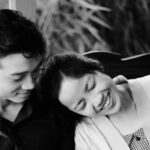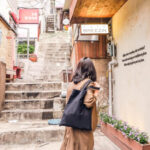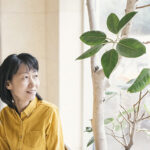
If you’re looking for more novels to get you through this fall season, you’re in luck. Publications of fantastic Korean novels in translation aren’t slowing down. For your information and consideration, here are six new and recent translations of Korean novels of all different genres that are sure to keep you engaged.
Love in the Big City by Sang Young Park (trans. Anton Hur)
Set in Seoul, Sang Young Park’s novel Love in the Big City follows Young, a gay Korean man, during four acts of his life. When we first meet him, he’s a college student who revels in drinking and hookups on Tinder. After his nightly adventures, he dishes about his lovers with Jaehee, a woman who’s his roommate and best friend.
Though the novel opens with a lighthearted beginning, it closes with a more weighty ending. When Jaehee gets serious with her fiancé and leaves Young to start her own life, Young’s glittering outings of carousal and flings start to dim as he himself grows older. He cares for his ailing Catholic mother and launches his career as a writer. Meanwhile, he meets two men that he must choose between.
Park’s novel thoughtfully explores the aching urban loneliness and stigma that Young faces in South Korean society as an HIV-positive gay man. Yet in spite of his marginalized position, Young manages to make his way through life with laughter and campy sarcasm—for instance, he christens his virus “Kylie” after Kylie Minogue.
Anton Hur’s translation of Love in the Big City is “[b]rilliant, glowing, and fun” and captures the subtle layers of emotion that accompany Young’s journey into adulthood. Check out this bestselling novel for an examination into how social relationships—whether with friends, family, or lovers—wax and wane in our lives as they push us to evolve.
Untold Night and Day by Bae Su-ah (trans. Deborah Smith)
Bae Su-ah’s novel Untold Night and Day is a surreal, drifting narrative in which nothing is quite as it seems. Kim Ayami, a 28-year-old woman, works at a theater for the blind. When the theater closes, Ayami loses her job. With nothing better in mind to do, she walks around Seoul during a heatwave.
Roaming somewhere between fantasy and reality without ever falling squarely into either, this oneiric novel about art, philosophy, and perception can take you on a fantastical trip over the course of one night and one day.
During her wandering, Ayami searches for a missing friend with her boss, learns some German, and spends time with a visiting German writer. Bae’s narrative warps these rather mundane events through confusion and disorientation—it’s never clear who any of these people actually are from one scene to the next, as their protean identities shift throughout the novel as if they were figments of a dream. The effect is mystical.
The novel seems to maintain that what is perceivable through our senses and cognition isn’t necessarily what is there. Objects, descriptions of people, and signs recur throughout the text, muddling the reader’s judgments and providing glimpses into other times and worlds. Additionally, the novel thematizes various levels of sightedness and blindness both physiological and psychological.
In this way, Untold Night and Day is suspended in a flux that never crystallizes into certainty. As if the novel were a hub for multiple realities and timelines that bleed into one another, ghostly traces are everywhere the reader looks.
Lemon by Kwon Yeo-Son (trans. Janet Hong)
In Kwon Yeo-Sun’s novel Lemon, the protagonist, Kim Da-on, mourns the mysterious death of her sister. With the 2002 FIFA World Cup craze in Korea serving as a backdrop, Kim Hae-on, an eighteen-year-old known for her beauty, is killed. Her case becomes known as the “High School Beauty Murder.”
There are two immediate suspects, but they are eventually cleared of suspicion, and the investigation remains an unsolved case. Left unknowing, Da-on languishes in the abyssal mystery surrounding her sister’s death. The novel tracks her mourning up to the present.
Kwon’s novel is loosely constructed as a murder mystery, and Da-on does independently investigate her sister’s death. Even so, cracking the case and identifying the killer are less important to the novel than its focus on the peculiar ways that loss and sustained absence affect Da-on’s behaviors. For example, Da-on gets plastic surgery to look more like her sister; she also names her own daughter Hye-eun, the name her mother wishes she had given Hae-on.
Author Kwon Yeo-Sun, whose “stories are as keen as a razor when it comes to exposing the hypocrisies of society, while simultaneously being warm and empathetic to the voiceless people of the world,” has won some of the most prestigious South Korean literary awards. These include the Yi Sang Literary Award in 2008 and the Hankook Ilbo Literary Award in 2012.
Check out this work for a short and subtle novel that explores social class, the pains of denied closure, and the symptoms of grief.
One Left by Kim Soom (trans. Bruce Fulton & Ju-Chan Fulton)
Kim Soom’s novel One Left is a hybrid form of history and fiction that gives voice to the experiences of Korean “comfort women.” It’s estimated that more than 200,000 women and girls were enslaved by the Japanese military to serve in “comfort stations,” hellish colonial institutions where Japanese soldiers raped and abused the comfort women. An estimated 20,000 comfort women survived. One Left tells the story of one such survivor.
The protagonist was abducted when she was thirteen and spent seven years as a comfort woman for the Japanese military in Manchuria. She describes a life of endless rapes, beatings, diseases, and deaths. Once she makes it back to South Korea, she lives in poverty and secrecy, haunted by her girlhood that was stolen from her and threatened by the stigma that surrounds comfort women in South Korean society.
She decides to act when she sees on TV that, after the passing of another comfort woman, there is only one last publicly known comfort woman left. She is also dying. Hearing this, the protagonist, now in her nineties, wishes to visit her to tell her that she is not alone, that she is not the last one left. She also wants to tell her own story.
Bolstering the novel’s fictional representations with historical substance, Kim Soom backs up her writing with endnotes that reference real testimonies given by comfort women. This historical grounding packs a punch, as it reminds the reader that the disturbing, gut-wrenching experiences described in the novel were real conditions that comfort women were forced to endure.
Readers should be aware that this book is not an easy read. Even so, it critically remembers a traumatic history that has been repressed and obscured by overwhelming political and social forces.
Painter of the Wind by Lee Jung-myung (trans. Hannah Pang & Stella Kim)
The upcoming translation of Lee Jung-myung’s novel Painter of the Wind imagines the painterly world of the Joseon Dynasty in the eighteenth century. The synopsis from Harriett Press explains that the novel centers on Shin Yun-bok and Kim Hong-do, two giants of Korean painting.
In South Korea, Painter of the Wind was adapted into the hit SBS TV series of the same name. The show brought fame to both Lee and his novel, which has sold over one million copies.
In the novel, Kim Hong-do acts as a mentor to Shin Yun-bok, who strains against the conventions of the Royal Academy of Painting. After both Hong-do and Yun-bok end up expelled from the Royal Academy, the king orders them to investigate the deaths of the painters Kang Su-hang and Seo Jing. Intriguingly, it turns out that the latter died when investigating the former’s death.
Surrounding this plot are the novel’s vibrant depictions of the Joseon Dynasty. Lee portrays everyday life with detailed strokes; and while the text animates the historical figures of Shin Yun-bok and Kim Hong-do through words, it also includes color images of some of their most famous paintings.
As a blend of fact and fiction that explores Korean art history and Joseon culture, Lee’s novel also contains curiosity and mystery, even questioning whether Shin Yun-bok was, actually, a man.
The Cabinet by Un-su Kim (trans. Sean Lin Halbert)
In The Cabinet, Kong Deok-geun is a bored office worker itching to find a better way to spend his hours at work. When he investigates—or rather, breaks into—Cabinet 13, he finds within the filing cabinet an archive of documentation on people called “symptomers.”
Symptomers in the novel are believed to be people who represent the next developments in human evolution. Some of them eat glass, others travel through time, and one has a ginkgo tree growing from his finger. A certain Professor Kwon has maintained the files on the symptomers in Cabinet 13, and once Deok-geun finds out about them, he begins to work for Professor Kwon to take care of the files as well.
The novel’s sections cover specific symptomer cases from the cabinet as well as scenes from Deok-geun’s own life. Over time, the stories in the cabinet intertwine with Deok-geun’s situation, as he ends up interacting with the symptomers—sometimes to his irritation. In the end, Deok-geun gets more than he bargained for, as he winds up embroiled in a plot by a syndicate to get a hold of the files in Cabinet 13 for themselves.
When it was first published in 2006, The Cabinet won the Munhakdongne Novel Award, one of South Korea’s most prestigious literary prizes. Consider picking up this novel for a humorous and uncanny take on office culture, capitalism, and othering that isn’t quite supernatural but certainly isn’t ordinary, either.
















